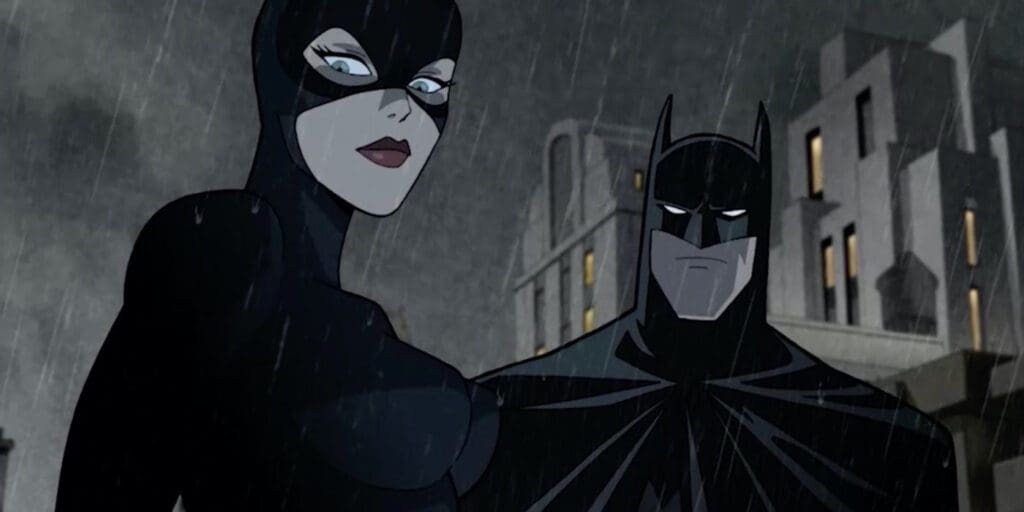Summary
Another of Batman’s most iconic cases gets the animated adaptation treatment, but this is a pretty good one.
The DC Universe Animated Original Movies line has an understandable if lamentable fascination with Batman. Since the last one, Justice Society: World War II, wasn’t specifically marketed around the Caped Crusader, someone at Warner Bros. Animation must have woken up in the night with cold sweats and ensured that the next one wasn’t just a Batman story, but an adaptation of one of the Batman stories. Jeph Loeb and Tim Sale’s Batman: The Long Halloween is up there with The Killing Joke, The Dark Knight Returns, and Batman: Year One when it comes to all-time-great Bat stories.
Its importance was obviously recognized, since this, like The Dark Knight Returns, has been divided up into two parts, with the second slated for release in July. This is the sensible decision and the film, which runs for a cool 90-ish minutes and isn’t in a rush about things, is much better for it. A yearlong murder mystery is plenty to be going on with on its own, but this is also a character study of an early-career Batman, the origins of District Attorney Harvey Dent’s transition into Two-Face, and a mob story since Batman (now played by Jenson Ackles, who played Jason Todd in Under the Red Hood) teams up with Dent (Josh Duhamel) to take down the head of the Falcone crime family (Titus Welliver) following a murder on, you guessed it, Halloween.
The crime war backgrounds the exploits of the Holiday Killer as time goes on and more bodies pile up, and we also begin to intersect with the personal stories of several Batman regulars, such as Police Captain James Gordon (Billy Burke) and Catwoman (Naya Rivera in one of her final roles), as well as slightly underused second stringers such as Calendar Man (David Dastmalchian). It’s a lot, but the two-part format gives it all space to breathe. The days of hastily crammed-together adaptations in this line seem to be a thing of the past, and there’s always a chance, given artistic license and all, that even those familiar with the source material will be surprised by the eventual outcome.
READ: 10 Best DC Animated Movies you must watch
Of course, source material this well-loved and seminal will never be allowed a totally smooth adaptation. Die-hard purists will always be waiting in the wings to point out which scenes are direct lifts, which are new, and where all the seams are. Batman: The Long Halloween, Part One is going to be subject to those criticisms, but I’d wager that most of the changes that were either made or not made here make sense in context. Some are improvements, some are forgivable omissions for justifiable reasons, but almost nothing seems out of place or totally ill-advised.
The voice cast helps to sell it all regardless. Ackles makes a good, arrogant, but naïve Batman; Troy Baker’s Mark Hamill-inspired Joker is a reliable bit of gonzo mania. But the standout, at least for me, was Dastmalchian’s Calendar Man, an underused but imposing figure who shows up mostly in an advisory capacity but lends one of Batman’s dullest rogues a sense of gravitas.
This whole line seems to have been softly rebooted after all the New 52 shared-universe malarkey, and so Batman: The Long Halloween, Part One has the same thick-lined visual style as the aforementioned Justice Society: World War II and Superman: Man of Tomorrow. It works on a more grounded level than some of the visual design elements seen in, say, Justice League Dark: Apokolips War, which is fitting for the more scaled-back story. Most viewers were sick of those garish quasi-futuristic costumes anyway, not to mention such time-bending excess; this more true-to-source look seems to be symbolic of a more conscientious storytelling style that gets back to the essence of what makes Batman and Gotham City such compelling cultural fixtures. The film might not be perfect, but at least it feels like it understands its own appeal.



